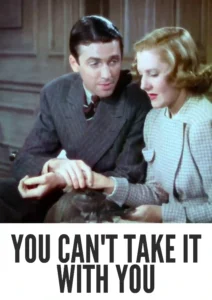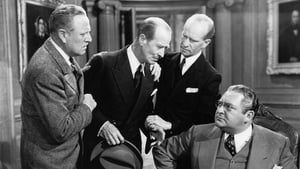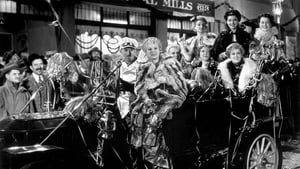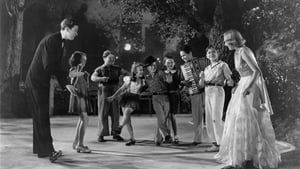Video Sources 0 Views
- Watch trailer
- You Can't Take It with You 1938 Colorized


Synopsis
Table of Contents
ToggleEccentric Family, Timeless Charm: You Can’t Take It with You (1938) in Stunning Color

Step into the whimsical world of Frank Capra with You Can’t Take It with You, a delightful screwball comedy from 1938, now beautifully colorized for a viewing experience like never before. This film, directed by Frank Capra, delivers a heartwarming blend of humor, romance, and social commentary within the confines of an unconventional family. Perfect for classic film enthusiasts and those seeking a dose of Capra’s signature optimism, this HD download brings a beloved piece of cinematic history to your screen. The movie also had other titles like “Holiday“, “Merton of the Movies“, and “You Can’t Take It With You“.
You Can’t Take It with You Storyline: A Clash of Cultures and a Celebration of Individuality
You Can’t Take It with You follows the story of Alice Sycamore (Jean Arthur), a sensible young woman from a delightfully eccentric family. Her life takes a chaotic turn when she falls in love with Tony Kirby (James Stewart), the son of a wealthy and conservative Wall Street banker.As Alice attempts to introduce her unconventional family to her fiancé’s straight-laced parents, comedic chaos ensues. The Sycamore family, with their passion for hobbies like playing the xylophone, writing plays, and collecting snakes, clashes hilariously with the Kirbys’ rigid and materialistic lifestyle. Amidst the madness, the film celebrates the importance of individuality, love, and living life to the fullest. You Can’t Take It With You ultimately reminds us that true happiness lies not in wealth or status, but in the relationships we cherish and the joy we find in everyday life.
Movie Cast
The film features a talented cast of actors who bring this heartwarming story to life:
- Jean Arthur as Alice Sycamore
- Lionel Barrymore as Grandpa Martin Vanderhof
- James Stewart as Tony Kirby
- Edward Arnold as Anthony P. Kirby
- Mischa Auer as Boris Kolenkhov
Movie Genre
You Can’t Take It with You falls into the genre of screwball comedy, with elements of romance and social commentary that are characteristic of Frank Capra’s directorial style. Its lighthearted tone and quirky characters make it a timeless and feel-good film.
Historical Context: Late 1930s Hollywood and Frank Capra’s Vision
Released in 1938, You Can’t Take It with You represents a high point in Frank Capra’s illustrious career, showcasing his optimistic vision and his ability to blend humor with social commentary. The film was produced during a period when Hollywood was embracing socially conscious storytelling. You Can’t Take It with You went on to win the Academy Award for Best Picture and Best Director, solidifying Capra’s reputation as one of the most influential filmmakers of his time.
Colorization Details
This colorized version of You Can’t Take It with You has been meticulously restored using modern digital techniques, enhancing the visual appeal while preserving the film’s original charm and warmth. The colorization process involved carefully analyzing the grayscale tones of the original black and white footage and assigning appropriate colors to each scene. While the specific software used remains proprietary, the techniques employed included advanced algorithms for color palette selection and image enhancement. This painstaking process brings new life to the characters and settings, making the story even more engaging for modern audiences. While some may debate the merits of colorizing classic films, it introduces these films to a broader audience, ensuring their legacy for future generations.
Technical Details
- Director: Frank Capra
- Screenplay: Robert Riskin
- Based on: the play by George S. Kaufman and Moss Hart
- Cinematography: Joseph Walker
- Edited by: Gene Havlick
- Production Company: Columbia Pictures
- Distributed by: Columbia Pictures
- Runtime: 126 minutes
Technical Specifications
- Download Format: MP4
- Resolution: HD (1080p)
- Compatibility: Compatible with most devices, including smartphones, tablets, computers, and smart TVs.
Reviews and Critical Reception
You Can’t Take It with You (1938) is widely regarded as one of Frank Capra’s finest films, celebrated for its heartwarming story, memorable characters, and optimistic message. It remains a beloved classic of American cinema, offering a timeless reminder of the importance of love, family, and living life on your own terms. As a socially conscious and entertaining film, You Can’t Take It With You provides a unique perspective on the values and ideals of the late 1930s.
FAQs
- Q: What is You Can’t Take It with You about?
- A: You Can’t Take It with You is a screwball comedy about a young woman from an eccentric family who falls in love with the son of a wealthy banker.
- Q: Is You Can’t Take It with You (1938) a well-known Frank Capra film?
- A: Yes, You Can’t Take It with You is one of Frank Capra’s most celebrated works, known for its heartwarming story and optimistic message.
- Q: Is this version of You Can’t Take It with You colorized?
- A: Yes, this version has been professionally colorized to enhance the viewing experience.
- Q: What makes You Can’t Take It with You interesting for Capra fans?
- A: You Can’t Take It with You showcases Frank Capra’s signature style, blending humor, romance, and social commentary in a heartwarming and uplifting way.
- Q: What is the download format?
- A: The download format is MP4, which is compatible with most devices.
- Q: What resolution is the download?
- A: The resolution is HD (1080p), providing a high-quality viewing experience.
Download Now in HD!
Watch You Can’t Take It with You Today!




















